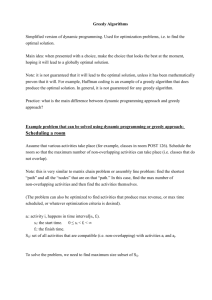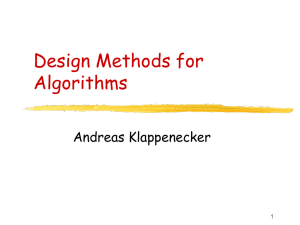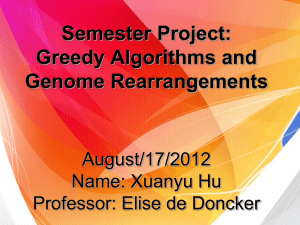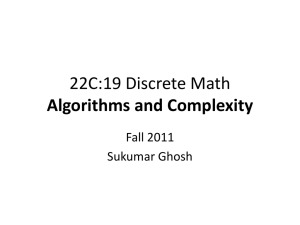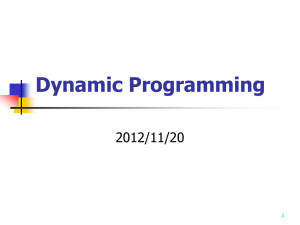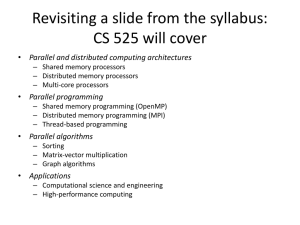Chapter16,pptx
advertisement
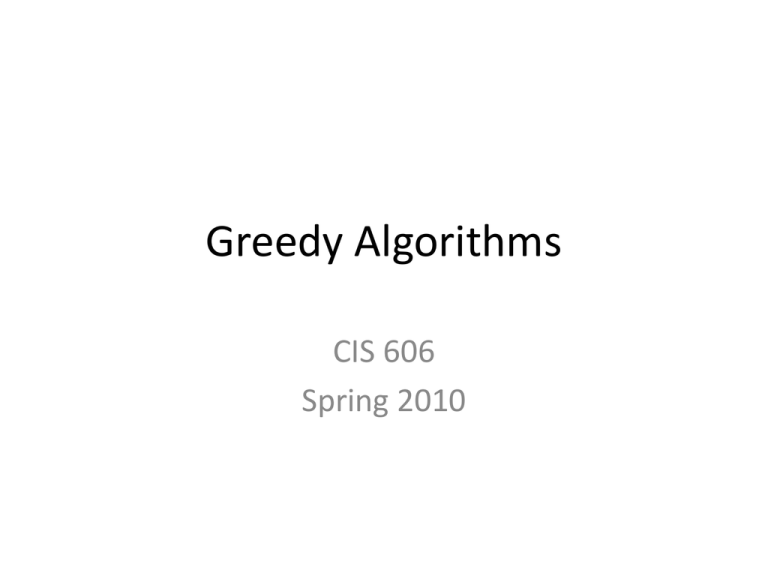
Greedy Algorithms
CIS 606
Spring 2010
Greedy Algorithms
• Similar to dynamic programming.
• Used for optimization problems.
• Idea
– When we have a choice to make, make the one that
looks best right now. Make a locally optimal choice in
hope of getting a globally optimal solution.
• Greedy algorithms don’t always yield an optimal
solution. But sometimes they do. We’ll see a
problem for which they do. Then we’ll look at
some general characteristics of when greedy
algorithms give optimal solutions.
Activity selection
• n activities require exclusive use of a common
resource. For example, scheduling the use of a
classroom.
• Set of activities S = {a1, . . . , an}.
• ai needs resource during period [si, fi), which is a
half-open interval, where si = start time and fi =
finish time.
• Goal
• Select the largest possible set of nonoverlapping
(mutually compatible) activities.
Activity selection
• Note
• Could have many other objectives:
– Schedule room for longest time.
– Maximize income rental fees.
• Assume that activities are sorted by finish
time: f1 ≤ f2 ≤ f3 ≤ . . . ≤ fn-1 ≤ fn.
Example
• S sorted by finish time:
Optimal substructure of activity
selection
• Sij = {ak ∈ S : fi ≤ sk < fk ≤ sj}
•
= activities that start after ai finishes and
finish before aj starts :
• Activities in Sij are compatible with
– all activities that finish by fi , and
– all activities that start no earlier than sj.
Optimal substructure of activity
selection
• Let Aij be a maximum-size set of mutually
compatible activities in Sij .
• Let ak ∈ Aij be some activity in Aij . Then we
have two subproblems:
– Find mutually compatible activities in Sik (activities
that start after ai finishes and that finish before ak
starts).
– Find mutually compatible activities in Skj (activities
that start after ak finishes and that finish before aj
starts).
Optimal substructure of activity
selection
• Let
• Aik = Aij ∩ Sik = activities in Aij that finish before ak
starts ;
• Akj = Aij ∩ Skj = activities in Aij that start afer ak
finishes :
• Then Aij = Aik ∪{ak } ∪Akj
• ⇒ ⎮Aij⎮= ⎮Aik⎮ + ⎮Akj⎮+ 1.
• Claim
• Optimal solution Aij must include optimal
solutions for the two subproblems for Sik and Skj.
Proof
• Use the usual cut-and-paste argument. Will show
the claim for Skj; proof for Sik is symmetric.
• Suppose we could find a set A’kj of mutually
compatible activities in Skj, where ⎮A’kj⎮>
⎮Akj⎮
• Then use A’kj instead of Akjwhen solving the
subproblem for Sij.
• Size of resulting set of mutually compatible
activities would be ⎮Aik⎮+ ⎮A’kj⎮ + 1 >
• ⎮Aik⎮+ ⎮Akj⎮ + 1 = ⎮A⎮. Contradicts
assumption that Aij is optimal.
One recursive solution
– Since optimal solution Aij must include optimal
solutions to the subproblems for Sik and Skj, could
solve by dynamic programming.
– Let c[i, j] = size of optimal solution for Sij. Then
– c[i, j] = c[i, k] + c[k, j] + 1:
– But we don’t know which activity ak to choose, so we
have to try them all:
– Could then develop a recursive algorithm and
memoize it. Or could develop a bottom-up algorithm
and fill in table entries.
– Instead, we will look at a greedy approach.
Making the greedy choice
• Choose an activity to add to optimal solution before
solving subproblems. For activity-selection problem,
we can get away with considering only the greedy
choice: the activity that leaves the resource available
for as many other activities as possible.
• Question: Which activity leaves the resource available
for the most other activities?
• Answer: The first activity to finish. (If more than one
activity has earliest finish time, can choose any such
activity.)
• Since activities are sorted by finish time, just choose
activity a1.
Making the greedy choice
• That leaves only one subproblem to solve: finding
a maximum size set of mutually compatible
activities that start after a1 finishes. (Don’t have
to worry about activities that finish before a1
starts, because s1 < f1 and no activity ai has finish
time fi < f1 ⇒ no activity ai has fi ≤ s1 .)
• Since have only subproblem to solve, simplify
notation:
• Sk = {ai ∈ S : si ≥ fk} = activities that start after ak
finishes.
Making the greedy choice
• Making greedy choice of a1 ⇒ S1 remains as
only subproblem to solve.
• By optimal substructure, if a1 is in an optimal
solution, then an optimal solution to the
original problem consists of a1 plus all
activities in an optimal solution to S1 .
• But need to prove that a1 is always part of
some optimal solution.
Theorem
• If Sk is nonempty and am has the earliest finish time in
Sk, then am is included in some optimal solution.
• Proof Let Ak be an optimal solution to Sk, and let aj
have the earliest finish time of any activity in Ak . If aj =
am , done. Otherwise, let A’k = Ak – {aj} ∪ {am} but with
am substituted for aj.
• Claim
• Activities in A’k are disjoint.
• Proof Activities in Ak are disjoint, aj is first activity in Ak
to finish, and fm ≤ fj. (proves claim)
• Since |A’k| = |Ak|, conclude that A’k is an optimal
solution to Sk, and it includes am. (proves theorem)
• So, don’t need full power of dynamic
programming. Don’t need to work bottomup.
• Instead, can just repeatedly choose the
activity that finishes first, keep only the
activities that are compatible with that one,
and repeat until no activities remain.
• Can work top-down: make a choice, then solve
a subproblem. Don’t have to solve
subproblems before making a choice.
Recursive greedy algorithm
• Start and finish times are represented by arrays s
and f , where f is assumed to be already sorted in
monotonically increasing order.
• To start, add fictitious activity a0 with f0 = 0, so
that S0 = S, the entire set of activities.
• Procedure REC-ACTIVITY-SELECTOR takes as
parameters the arrays s and f, index k of current
subproblem, and number n of activities in the
original problem.
Recursive greedy algorithm
Recursive greedy algorithm
• Idea
• The while loop checks ak+1, ak+2, . . . , an until it finds an
activity am that is compatible with ak (need sm ≥ fk).
– If the loop terminates because am is found (m > n), then
recursively solve Sm , and return this solution, along with
am .
– If the loop never finds a compatible am (m > n), then just
return empty set.
• Time
• Θ(n) —each activity examined exactly once, assuming
that activities are already sorted by finish times.
Iterative greedy algorithm
– Can convert the recursive algorithm to an iterative
one. It’s already almost tail recursive.
Greedy strategy
• The choice that seems best at the moment is the one
we go with.
• What did we do for activity selection?
1. Determine the optimal substructure.
2. Develop a recursive solution.
3. Show that if we make the greedy choice, only one
subproblem remains.
4. Prove that it’s always safe to make the greedy choice.
5. Develop a recursive greedy algorithm.
6. Convert it to an iterative algorithm.
Greedy strategy
• At first, it looked like dynamic programming. In the
activity-selection problem, we started out by defining
subproblems Sij, where both i and j varied. But then
found that making the greedy choice allowed us to
restrict the subproblems to be of the form Sk.
• Could instead have gone straight for the greedy
approach: in our first crack at defining subproblems,
use the Sk form. Could then have proven that the
greedy choice am (the first activity to finish), combined
with optimal solution to the remaining compatible
activities Sm, gives an optimal solution to Sk.
Greedy strategy
• Typically, we streamline these steps:
1. Cast the optimization problem as one in which we
make a choice and are left with one subproblem to
solve.
2. Prove that there’s always an optimal solution that
makes the greedy choice, so that the greedy choice is
always safe.
3. Demonstrate optimal substructure by showing that,
having made the greedy choice, combining an optimal
solution to the remaining subproblem with the greedy
choice gives an optimal solution to the original
problem.
Greedy strategy
• No general way to tell whether a greedy
algorithm is optimal, but two key ingredients
are
1. greedy-choice property and
2. optimal substructure.
Greedy-choice property
• Can assemble a globally optimal solution by
making locally optimal (greedy) choices.
• Dynamic programming
– Make a choice at each step.
– Choice depends on knowing optimal solutions to
subproblems. Solve subproblems first.
– Solve bottom-up.
• Greedy
– Make a choice at each step.
– Make the choice before solving the subproblems.
– Solve top-down.
Greedy-choice property
• Typically show the greedy-choice property by
what we did for activity selection:
– Look at an optimal solution.
– If it includes the greedy choice, done.
– Otherwise, modify the optimal solution to include the
greedy choice, yielding another solution that’s just as
good.
• Can get efficiency gains from greedy-choice
property.
– Preprocess input to put it into greedy order.
– Or, if dynamic data, use a priority queue.
Optimal substructure
• The knapsack problem is a good example of
the difference.
• 0-1 knapsack problem
– n items.
– Item i is worth $vi, weighs wi pounds.
– Find a most valuable subset of items with total
weight ≤ W.
– Have to either take an item or not take it—can’t
take part of it.
Optimal substructure
• Fractional knapsack problem
• Like the 0-1 knapsack problem, but can take fraction of
an item.
• Both have optimal substructure.
• But the fractional knapsack problem has the greedychoice property, and the 0-1 knapsack problem does
not.
• To solve the fractional problem, rank items by
value/weight: vi/wi . Let vi/wi ≥ vi+1/wi+1 for all i. Take
items in decreasing order of value/weight. Will take all
of the items with the greatest value/weight, and
possibly a fraction of the next item.

